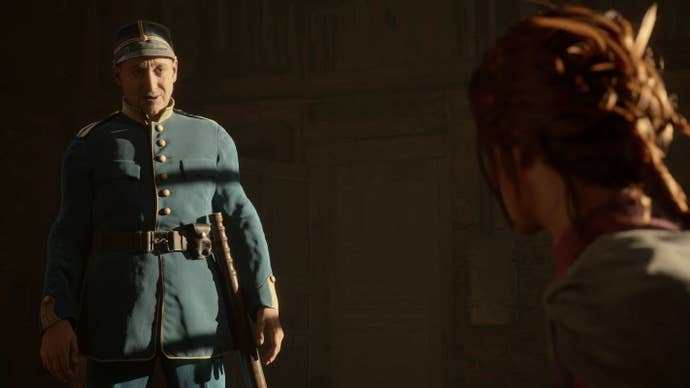Have you seen Eriksholm: The Stolen Dream knocking about? I can’t seem to find it. It’s an upcoming adventure game about some sneaky urchins from a fictional Scandilike country in the 1900s. We’ve previously described it as “a bit Dunwall and a bit Desperadoes”. I got to play a short preview build, and being offered its toylike city from a top-down perspective made me eager to explore and find its many collectible artworks. It’s a lavishly animated and handsomely modeled piece of work. But, well, its approach to stealth veers bland and predictable. I don’t know if sunkissed tiles and cobblestone alleyways are enough to forgive what so far appears to be an entire game based on the derided “instafail stealth section”. But sit down, we can talk about it.
You play as Hanna, a resourceful orphan looking for her brother Hermann, who has gone on the lam from the town cops. As a ragamuffin native to Eriksholm, Hanna knows the streets well, and we get a sense of a girl who has also given the law boys the runaround plenty of times. There’s also a disease floating about – the Heartpox – which causes rashes, fever, and usually death. But Hanna survived her unconscious battle with the illness and has awoken ignorant of whatever cheeky escapades her bro has been up to during her convalescence. You soon shake off a questioning copper, and off you go into the city’s various districts to find your sibling and slap his wrist.
Except, of course, he’s nowhere to be found. With the police now looking for both of you, it becomes a clicky top-down adventure about avoiding the lawmen’s patrols and getting from one end of town to another, with a few collectible items and storytelling notes to pocket along the way. “Eriksholm!” boasts one poster you find. “Rosmark’s gate and bastion”. A map of this country, Rosmark, shows a Nordic sub-continent of fjords and islands, with neighbouring countries looming around it. Signs of turn-of-the-century industrialsation fill the city (motorcars, factories, electric bridges) and there are whispers of a not-so-distant war.
There’s a lot of this worldbuilding going on, with solid voice acting and motion capture during cinematics too. Facial expressions aren’t quite Supermassive levels of uncanny valley, but they’re surprisingly close. And the realistic lighting of Unreal Engine’s lumen is put to use to create a colourwashed world full of linen and still-life fruit that might easily have been the subject of a painting by European realists of the late 19th century. It’s maybe even going overboard – do you appreciate every neat fold of fabric in a game that you mostly view from 20 meters above? I probably don’t.
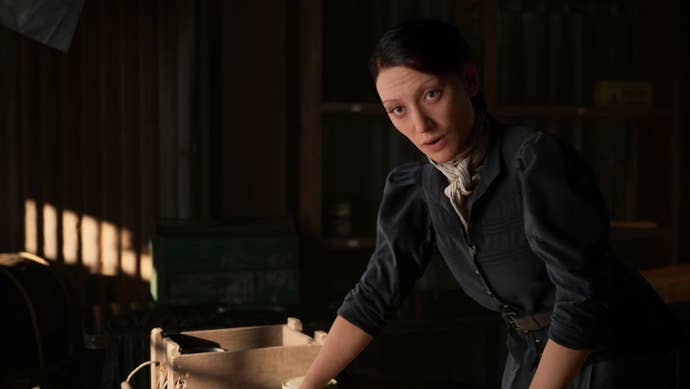
Still, when you step out of the tutorial factory and into the city proper you see an inviting maze of tiled roofs, church towers, and cobbly streets. Faded advertisements are plastered everywhere, ivy creeps up the brickwork. As a big fancier of European old towns built on increasingly high tiers of arched stone I am always happy to see twisty narrow alleys passing under shady bridges, and happier still when the metropolitan diorama becomes explorable. The paths you need to take aren’t terribly complex in this opening chapter, but if the game can offer more free-form roaming in similar cityscapes, it might be onto something.
Or it might just be rats. The game’s stealth gives me pause amid the pleasant sights. It’s based mainly around sound. Metal floors, banging doors, and creaky valves will give you away to the ears of the guards that prick up in the form of a clear meter that fills above their heads. A crowd of birds will fly off as you approach and alert enemies (or become a useful distraction, giving you time to clamber over a nearby fence). One early puzzle sees you turning on a steam engine that shifts crates, so you can hide behind the cargo as its moves. Mostly, though, the demo showcased a classic selection box of patrol patterns in which you dander past guards while their back is turned.
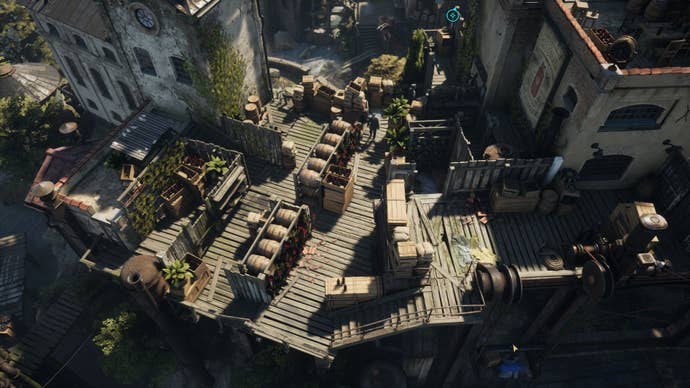
A later chapter gives Hanna a blowgun with sleeping darts, and teaches you to hide bodies after sending them to kip. Another section teams you up with a friendly mentor in the criminal arts, who can throw an item to distract guards. You can swap between characters instantly, the idea being that you work together to distract from one angle while sneaking past from another.
None of this feels new or exciting in terms of the stealth game. In fact, Eriksholm appears positively uninterested in the genre even while adopting its many trappings. When you’re caught by a guard, you are simply hit with an instafail screen and restart from a nearby checkpoint. There’s no recovery tactics or last-ditch attempts to kick a shin and scarper off. At least none in the parts I’ve played.
For me this remains a disappointingly unimaginative way to design games about sneakery. The failstate as a shrug. The stealth genre faced a question from the moment of conception: what happens when a player is caught? Metal Gear Solid‘s solution was a quick sprint into a nearby vent until a countdown ran out. Developers have since come up with their own approaches to the alerting of enemies. The re-costuming hijinks of Hitman, the panicked parkour and crowd-joining of Assassin’s Creed, or more recently, the walkie-talkie wackiness of Skin Deep, in which you must end an alert by calling in an “all-clear” over the enemy’s own radio system.
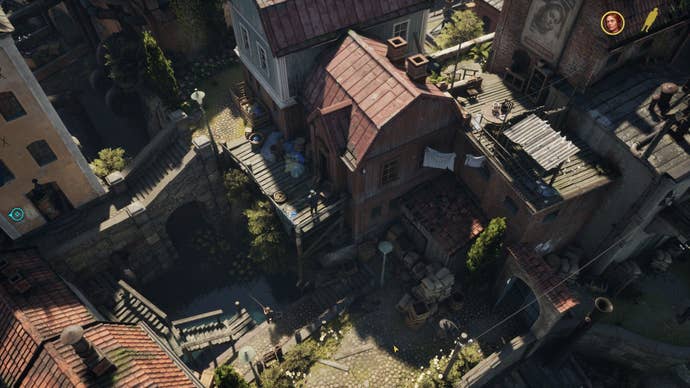
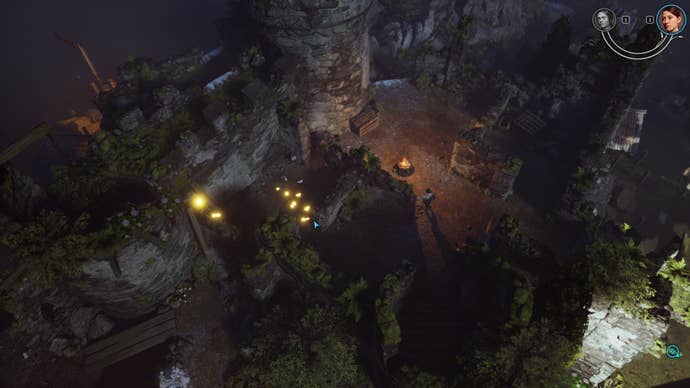
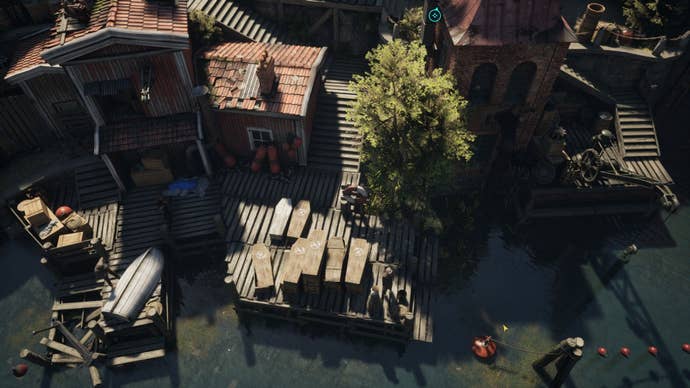
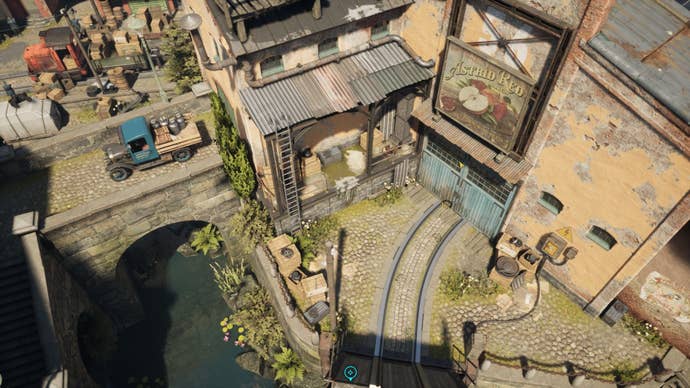
By contrast, Eriksholm chooses not bother to allow for recovery at all. You’re spotted? Try again. It is a stealth game, but when goons are alerted it takes the same abrupt solution infamously employed in action blockbusters of the late 2000s (think of all those games that included a single throwaway stealth section to appease some marketing schlemiel). Game over, go again. To me, that’s dated and uninteresting, no matter how frictionless you make restarts with generous checkpoints. It’s equally unflattering next to genre-redefining games like Mimimi’s stealth tactics bangers, which were punishing if you were spotted, yes, but still allowed you to recover from an alarm, and felt rewarding when a plan was executed perfectly.
So yeah, that’s the main hunk of salted fish stuck in my craw when it comes to this one. Next to all the other stealth ’em ups, Eriksholm might blend in a little too well. That may not be a killer for everyone, I realise. Like I say, the visual flair and decent acting might be enough to get you through. Sometimes a game can simply sit within its genre as plain as a cube of boiled tofu, and feel filling and satisfying nonetheless. I’m thinking of the Plague Tale games, which stuck to lots of third-person action adventure conventions, yet which carried me through by sheer power of their historical setting and swish recreation of oldy worldy props. But then, even Plague Tale had magic rats. We’ll have to wait and see what more Eriksholm has, when it reveals itself some time later this year.

